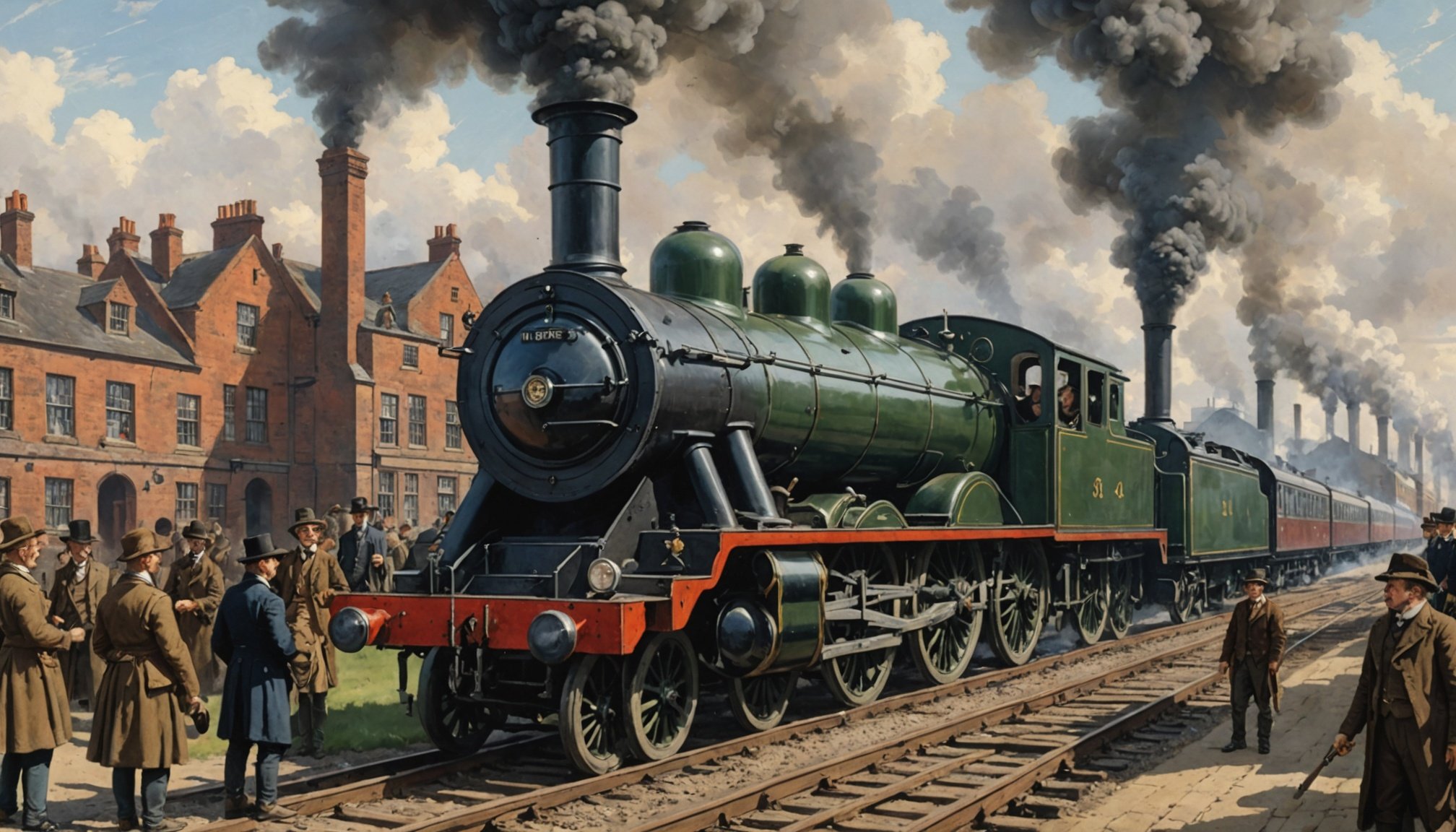Overview of the British Industrial Revolution
The British Industrial Revolution, occurring between the late 18th and early 19th centuries, is a pivotal era marked by significant transformation. It redefined production, society, and the global economy, establishing a new framework of technological progress and societal evolution. This period saw advancements in various areas, each contributing uniquely to its historical significance.
Societal changes were profound during this time. The rise of machines and factories altered daily lives, moving many from agrarian work to industrial labor. As the country adapted, cities expanded, resulting in burgeoning urban centers. This shift not only modified the landscape but created ripples affecting economic structures and cultural dynamics alike.
Also to read : Explore urban bivouac: a unique hotel experience in paris
Several transformative events punctuated this period. These included the widespread adoption of new machinery, the transition from handcraft to mechanized production, and the expansion of transportation networks. By setting the stage for future industrialization, the British Industrial Revolution left an indelible mark on history.
These elements outline the significant themes to be further explored. Understanding them provides insight into how they influenced modern industrial practices and societal norms. This exploration is essential to grasp the historical significance of these transformative events.
This might interest you : Discover must-have vintage art prints and japan posters
Major Events and Milestones
The British Industrial Revolution was not merely a passage in history; it was a catalyst for momentous change. Key events during this era laid a foundation for the modern world. The transformation commenced with the Agricultural Revolution: a precursor that catalysed a shift from farming to industrial powerhouses. Enhanced agricultural efficiency supported population growth, creating a labour surplus vital for industrialization.
The Invention of the Steam Engine was pivotal. It emerged as one of the era’s most crucial milestones, revolutionising production and transportation. James Watt’s improvements on this invention propelled industries and facilitated faster commutes, thereby knitting cities together.
As we explore the Rise of Factories, it is crucial to recognise their role in transitioning economies from agrarian to manufacturing. Factories centralized production, fostering an environment where innovation thrived. The introduction of the assembly line and mechanized production improved efficiency and reshaped labor dynamics.
The Industrial Revolution was punctuated by these milestones that set a historical timeline in motion. These events not only moulded the past but continue to inform present-day industrial practices and societal configurations. Understanding them provides insight into profound historical significance.
Pivotal Figures in the Industrial Revolution
The Industrial Revolution was driven by remarkable individuals whose innovations and influence were nothing short of transformative. James Watt stands out for his enhancements to the steam engine, heightening its efficiency and utility in factories and transportation. This invention was pivotal in reshaping power systems and accelerating industrial growth. Watt, a skilled Scottish engineer, transformed steam into a formidable force, establishing a cornerstone for modern machinery.
Another key figure, Richard Arkwright, revolutionized the textile industry with the development of the water frame. His innovation enabled large-scale textile production, leading to the birth of the factory system. Arkwright’s entrepreneurial spirit and ingenuity facilitated the shift to mechanised manufacturing, cementing his status as a major influencer in industrial practices.
Isambard Kingdom Brunel contributed heavily to infrastructure and transportation. As a visionary engineer, he designed revolutionary structures like the Great Western Railway and various notable bridges. Brunel’s projects not only improved connectivity across Britain but also showcased ambitious engineering prowess. Together, these pioneers drove technological advancement and societal change, leaving a legacy that continues to inspire and inform modern industrial undertakings.
The Technological Innovations
The Industrial Revolution was a powerhouse of technological advancements, setting the stage for modern industry. Central to this transformation was the remarkable evolution of machinery, which drove unprecedented change. The textile industry was pivotal, where devices like the spinning jenny and the power loom revolutionised textile manufacturing by significantly increasing efficiency and output.
Steam power was another groundbreaking innovation that reshaped both transportation and manufacturing landscapes. The introduction of steam engines powered trains, ships, and factories, facilitating faster travel and more reliable production processes. Its impact was monumental, creating interconnected cities and streamlining industrial activities.
As factories flourished, they became hubs of technological progress, adopting inventions that automated many aspects of production. These innovations not only boosted productivity but also set new standards for industrial practices. The shift from manual labor to mechanised systems marked a significant technological leap that resonates in today’s manufacturing processes.
These advances laid a robust foundation for the industrial architecture we observe now, embedding the Industrial Revolution in the fabric of modern technology and machinery. It was a period that underscored the profound influence of innovation on society and the economy.
The Social Impact of the Industrial Revolution
The Industrial Revolution catalysed profound social changes, fundamentally altering the societal landscape. One of the most notable shifts was the transformation in labor dynamics. Previously dominated by agrarian work, many transitioned to industrial employment, marking the rise of factory jobs as a cornerstone of societal structure. This was marked by ambitious urbanisation, reshaping communities and cultural identities.
Urbanization accelerated, with cities expanding rapidly to accommodate an influx of workers seeking factory employment. This growth spurred the development of new infrastructures and public services, fostering bustling cities rife with opportunity and challenge. Consequently, urban centres became melting pots of diverse cultural and social interactions, birthing a burgeoning middle class.
The period also ignited the Workers’ Rights Movement, born out of harsh working conditions in factories. As industrialisation progressed, labourers began advocating for improved conditions and fair wages, sowing the seeds for modern labour rights. These early movements played a crucial role in restructuring the workplace environment, echoing through to today’s labour standards.
Together, these transformative events encapsulated the British Industrial Revolution‘s significant impact on societal norms and continue to inform contemporary social and labor structures.
The Cultural Shift
The Industrial Revolution ignited a profound cultural shift, influencing art, literature, and societal values. As factories rose and cities expanded, new cultural identities emerged, shaping the artistic and literary landscapes.
Artists and writers reacted to the sprawling urbanization and industrial growth with reflections that captured the era’s dynamic essence. The stark contrasts between pastoral life and burgeoning industrial cities became vivid subjects, inspiring poetic and visual storytelling. Romanticism, a movement that shunned industrialization’s symbiosis with nature, flourished during this period. It celebrated emotion and nature’s beauty amidst the mechanical ascension.
Industrial landscapes began to permeate paintings and literature, shaping narratives rich in complexity. Writers like Charles Dickens offered social commentary on the challenges and inequalities bred by rapid industrialization. His works highlighted the societal disparities stemming from the era, reflecting both admiration and critique of contemporary changes.
Furthermore, the British Industrial Revolution instigated the formation of modern cultural identities. It embraced a blend of traditional and progressive views, spurred by an era of inventive vigor. Ultimately, the cultural expressions of this period laid foundational narratives for modern arts and society, melding innovation with humanity’s evolving ethos.
Interactive Elements and Resources
Understanding the British Industrial Revolution becomes more engaging with helpful tools like interactive maps, to visualize industrial growth. These maps offer a dynamic view of how industries developed throughout the country, showcasing the expansion of railways and manufacturing hubs. By exploring these maps, one can track the historical significance of regions pivotal to this transformative era.
Timelines of Key Events further provide context by highlighting milestones and pivotal moments in the revolution’s evolution. They visually organize the historical timeline, guiding readers through significant events like the Agricultural Revolution and the invention of the steam engine. This structured approach brings clarity, enhancing comprehension.
For enriched exploration, a curated list of suggested reading and resources serves as an educational treasure trove. These resources delve deeper into the transformative events and societal shifts of the era. They include books, articles, and documentaries, offering diverse perspectives on the revolution’s impact.
Using these elements, readers can gain a comprehensive understanding of how the Industrial Revolution shaped modern society, encouraging continued learning and exploration. The combination of visual aids, structured information, and further reading cultivates an immersive educational experience.
Conclusion and Call to Action
Embrace the opportunity to delve deeper into the British Industrial Revolution, a period brimming with historical significance. This transformative era offers countless avenues for exploration, appealing to both history enthusiasts and the curious-minded. By engaging with this pivotal chapter of history, readers can gain profound insights into the transformative events that have shaped our modern world.
Immersive experiences, such as visiting museums and historical sites, provide a tangible connection to the past, bringing to life the innovations and societal shifts of the era. These visits not only enrich knowledge but also foster a personal understanding of the era’s impact on contemporary society.
Additionally, numerous educational resources, including interactive maps and timelines, serve as valuable tools for those eager to pursue further exploration of the topic. These aids complement the narrative, offering structured context and dynamic views of the Industrial Revolution’s progression.
By embarking on this engaging journey, individuals are encouraged to continually learn and appreciate the enduring legacy of the British Industrial Revolution. It’s an invitation to engage with history in meaningful ways, fostering a lifelong passion for understanding the forces that have shaped our world.











